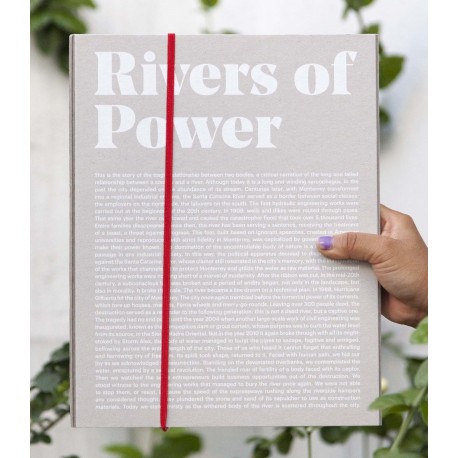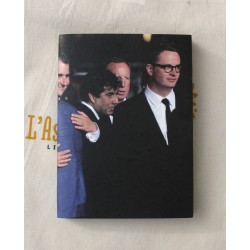No books
Rivers of Power (*signed*)
978-099666971-9
New
Text from the slipcase cover :
"This is the story of the tragic relationship between two bodies: a critical narration of the long and failed relationship between a society and a river. Although today it is a long and winding sarcophagus, in the past the city depended on the abundance of its stream. Centuries later, with Monterrey transformed into a regional industrial enclave, the Santa Catarina River served as border between social classes: the employers on the north side, the laborers on the south.
The first hydraulic engineering works were carried out at the beginning of the 20th century. In 1909, wells and dikes were routed through pipes. That same year the river overflowed and caused the catastrophic flood that took over 5 thousand lives. Entire families disappeared. Since then, the river has been serving a sentence, receiving the treatment of a beast, with its future in peril. (…)
The prolonged engineering works were nothing short of a marvel of modernity. After the ribbon was cut, in the mid-20th century, a subconscious link was broken and a period of aridity began, not only in the landscape, but also in morality. (…)
In 1988, Hurricane Gilberto hit the city of Monterrey. The city once again trembled before the torrential power of its currents, which tore up houses, markets, Ferris wheels and merry-go-rounds. Leaving over 300 people dead, the destruction served as a reminder to the following generation: this is not a dead river, but a captive one.
The tragedy had no end point until the year 2004 when another large-scale work of civil engineering was inaugurated, known as the Rompepicos dam or grout curtain, whose purpose was to curb the water level from its source, in the Sierra Madre Oriental. But in the year 2010 it again broke through with all its might: stoked by Storm Alex, the body of water managed to burst the pipes to escape, fugitive and enraged, bellowing across the entire length of the city.
Those of us who heard it cannot forget that enthralling and harrowing cry of freedom. (…)
-- Excerpts from the text by Ximena Peredo (see full text in "More info" tab) "
The text by Xemena Peredo is in Spanish on one side and in English on the other side of the slipcase.
An essay by Gonzalo Ortega is inserted in a 4-page leaflet insert, in Spansih and English. (NB : the signature of the artist is on this leaflet).
The book itself is inserted in a printed and rigid grey cardboard slip case, and held in place by a red elastic band. It is then wrapped in a poster, and sealed by a sticker.
Please note (!) : for any order that will include at least two books by Alejandro Cartagena (see "Suggestions" tab or these links : "Santa Barbara return jobs back to US" and "Carpoolers - 2nd edition"), we will add a poster published (300 printed - see picture) on the occasion of the exhibition Car Show by Alejandro Cartagena held in 2016 at "Galería Patrica Conde", Mexico City, Mexico.
144 pages - Softcover in a grey cardboard slipcase
Co-published by Alejandro Cartagena & NEWWER, 2016 (490 copies)
Format : 23 x 30 cm
*Signed*
New - Mint condition
Warning: Last books in stock!
More info
Complete text by Xemena Peredo :
"This is the story of the tragic relationship between two bodies: a critical narration of the long and failed relationship between a society and a river. Although today it is a long and winding sarcophagus, in the past the city depended on the abundance of its stream. Centuries later, with Monterrey transformed into a regional industrial enclave, the Santa Catarina River served as border between social classes: the employers on the north side, the laborers on the south.
The first hydraulic engineering works were carried out at the beginning of the 20th century. In 1909, wells and dikes were routed through pipes. That same year the river overflowed and caused the catastrophic flood that took over 5 thousand lives. Entire families disappeared. Since then, the river has been serving a sentence, receiving the treatment of a beast, with its future in peril.
This fear, built based on ignorant speeches, created in American universities and reproduced with strict fidelity in Monterrey, was capitalized by governments eager to make their power known. The domination of the uncontrollable body of nature is a necessary rite of passage in any industrial society. In this way, the political apparatus decided to display its strength against the Santa Catarina River, whose clamor still resonated in the city’s memory, with the inauguration of the works that channeled it to protect Monterrey and utilize the water as raw material.
The prolonged engineering works were nothing short of a marvel of modernity. After the ribbon was cut, in the mid-20th century, a subconscious link was broken and a period of aridity began, not only in the landscape, but also in morality. It broke the scale. The river was a line drawn on a technical plan.
In 1988, Hurricane Gilberto hit the city of Monterrey. The city once again trembled before the torrential power of its currents, which tore up houses, markets, Ferris wheels and merry-go-rounds. Leaving over 300 people dead, the destruction served as a reminder to the following generation: this is not a dead river, but a captive one.
The tragedy had no end point until the year 2004 when another large-scale work of civil engineering was inaugurated, known as the Rompepicos dam or grout curtain, whose purpose was to curb the water level from its source, in the Sierra Madre Oriental. But in the year 2010 it again broke through with all its might: stoked by Storm Alex, the body of water managed to burst the pipes to escape, fugitive and enraged, bellowing across the entire length of the city.
Those of us who heard it cannot forget that enthralling and harrowing cry of freedom. Its spirit took shape, returned to it. Faced with human pain, we hid our joy as we acknowledged its resurrection. Standing on the devastated riverbanks, we contemplated the water, enraptured by a sensual revolution. The frenzied roar of fertility of a body faced with its captor.
Then we watched the same entrepreneurs build business opportunities out of the destruction. We stood witness to the engineering works that managed to bury the river once again. We were not able to stop them, or resist, because the speed of the expressways rushing along the riverside hampers any considered thought. They plundered the stone and sand of its sepulcher to use as construction materials.
Today we stand thirsty as the withered body of the river is scattered throughout the city."

Cartagena, Alejandro
Alejandro Cartagena lives and works in Monterrey, Mexico. His projects employ landscape and portraiture as a means to examine social, urban and environmental issues. Photo: © self-portraitA Guide to Infrastructure and Corruption...
192 pages - Hardcover, tape-bound The Velvet Cell, 2017 (500 copies) Format : 14 x 21 cm *Signed* New - Mint condition Presentation of the photobook by Skinnerboox: " « A Guide to Infrastructure and Corruption is a long-term project that I started in 2009 when the opportunity to become a conscious citizen arose. A new overpass was to be built a block away...
46,00 €In StockBefore the War - 1st ed. (*signed*)
.Sold out.Presentation on the artist's website: "In 2008 the war against the drug cartels erupted in Mexico. The state of Nuevo Leon in northeastern Mexico became an increasingly violent place. This book is a compilation of images and texts that obsessively revisit places where the war was eventually fought and look for signs of an evil that lay...
Presentation on Alejandro Cartagena's website: "In 2008 the war against the drug cartels erupted in Mexico. The state of Nuevo Leon in northeastern Mexico became an increasingly violent place. This book is a compilation of images and texts that obsessively revisit places where the war was eventually fought and look for signs of an evil that lay underneath...
45,00 €In Stock
"V" Zine Set (*signed & numbered*)
.Sold out. Presentation by Julia Borissova: " I am fond of the artist book form and have created about 14 books over the past 10 years. Most of the titles are sold out. Some time ago I decided to rethink some of my projects and realize them in a new, more concentrated form of zines. In almost half a year I managed to implement this idea and today I am...
Project presentation by Christopher Héry: "22:19 illustrates the wide range of emotions - fear, boredom, camaraderie, relief - that two young men have experienced during an intense 8-minute period. This book has been designed to slowly reveal the location, the story, and its ending, to the viewer in a cinematographic manner. Time is the key element here...
68,00 €In StockA Short Story (*1st edition / signed*)
.Sold out.A 12-day love story, from the first hour to the last...Texts in English & Images by Thomas Boivin.108 pages - Softcover Self-published, 2016 (1st edition - 100 copies) *Signed* New - Mint condition





















